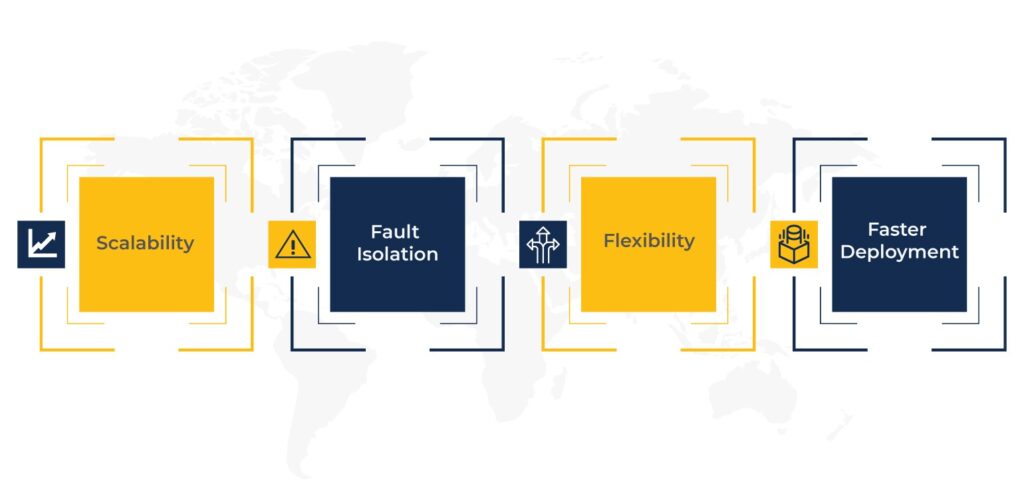In recent years, the shift toward microservices architecture has gained significant importance in the software development industry. Microservices present several benefits compared to conventional monolithic applications, such as enhanced scalability, better isolation of faults, and quicker deployment cycles. Converting a monolithic application into a microservices-based architecture can be a complex undertaking, but the benefits are well worth the effort.
In this article, we will explore the process of converting a monolithic application into a microservices-based application, along with some examples.
What are Monolithic Applications?
A monolithic application is a software application that is built as a single, indivisible unit. All the application components, such as the user interface, business logic, and data access layers, are tightly coupled and run within a single process.
Monolithic applications are often characterized by their large codebases, complex dependencies, and limited scalability.
Why Convert a Monolithic App into a Microservices-based App?
Microservices are an architectural style that structures an application as a collection of loosely coupled services. Each service is responsible for a specific business capability and can be developed, deployed, and scaled independently. The reason why a company should switch to a microservices based architecture is due to the immense benefits it offers, not to mention that monolithic apps are fast becoming outdated.

Here are some of the significant advantages of using a microservices-based architecture for your application.
-
Scalability
Microservices allow for horizontal scaling, meaning you can scale individual services independently based on demand. This enables better resource utilization and improved performance.
-
Fault Isolation
A major drawback of a monolithic application is that a problem in one of its components can bring down the entire app. But a microservices-based architecture isolates failures from specific services, ensuring that the rest of the system remains unaffected in case an application component is not functioning properly.
-
Flexibility
Microservices provide flexibility in technological choices. You can develop different services using various programming languages, frameworks, or databases based on specific requirements.
-
Faster Deployment
A microservices-based application enables faster deployment cycles since you can deploy each service independently. This allows for more frequent updates and feature releases.
Examples of Companies that Switched from Monolithic to Microservices-based Apps
Here are some examples of companies that have converted their monolithic applications to microservices architectures.
- Netflix – Netflix used to have a monolithic application for its video streaming service. The application was difficult to scale and maintain, so Netflix converted it to a microservices architecture. This allowed Netflix to scale its video streaming service to meet the needs of its growing user base.
- Amazon – Amazon’s monolithic application for its e-commerce website made it very challenging to add new features. By converting it to a microservices architecture, Amazon was able to add new features to its application seamlessly.
- eBay – eBay struggled to maintain its monolithic application for its online marketplace. Therefore, the company decided to switch to a microservices architecture, allowing it to improve the performance and reliability of its online marketplace.
How to Convert a Monolithic App into a Microservices App
Converting a monolithic application into a microservices based architecture involves several steps. Let us look at the high-level process:
-
Identify Business Capabilities
Analyze the monolithic application and identify distinct business capabilities or functionalities your development team can decouple into individual services. Each service should have a clear purpose and be responsible for a specific task.
-
Define Service Boundaries
Determine the boundaries between the identified services. This involves understanding the dependencies and interactions between different components of the monolithic application and defining how they can be split into separate services.
-
Refactor and Extract Services
Extract the identified services from the monolithic application, refactoring the code and separating the concerns. This step requires careful attention to ensure that each service is self-contained and has well-defined interfaces.
-
Establish Communication Mechanisms
Design and implement communication mechanisms between the services. You can achieve this through synchronous or asynchronous protocols, such as REST APIs, message queues, or event-driven architectures.
-
Data Management
Address the data layer by deciding how data will be managed across services. This may involve migrating to a microservices-friendly database or implementing data synchronization mechanisms.
-
Implement Service Orchestration
Define the overall flow and coordination of the services. This can be done using various approaches, including choreography or a centralized orchestration mechanism.
-
Implement Infrastructure and Deployment Automation
Set up the necessary infrastructure, such as containerization platforms or serverless environments, to support the deployment and management of microservices. Automate the deployment process to enable faster iterations and scaling.
A Practical Conversion Example
Let us input the steps mentioned above in a practical example to illustrate the conversion process. Suppose we have a monolithic e-commerce application that handles user registration, product catalog management, and order processing. Here is how the conversion might take place:
-
Identify Business Capabilities
Separate the user registration, product catalog, and order processing functionalities as individual services.
-
Define Service Boundaries
Determine the interactions and dependencies between the services. For example, the order processing service may need to communicate with the user registration service to validate customer information.
-
Refactor and Extract Services
Refactor the codebase, separating the user registration, product catalog, and order processing logic into separate services.
-
Establish Communication Mechanisms
Implement RESTful APIs or message queues to enable communication between the services. For example, the order processing service can make API calls to the user registration service for customer verification.
-
Data Management
Decide how data will be managed across services. It may involve replicating relevant data between services or adopting a distributed database solution.
-
Implement Service Orchestration
Define the overall flow and coordination of the services. For example, when a new order is received, the order processing service might trigger the user registration service to verify the customer’s information before processing the order.
-
Implement Infrastructure and Deployment Automation
Set up a containerization platform, such as Docker and Kubernetes, to deploy and manage the microservices. Automate the deployment process using CI/CD pipelines for faster iterations.
Conclusion
Converting a monolithic application into a microservices based application architecture is a complex process that requires careful planning and implementation. Organizations can reap the benefits of scalable, high-performing apps by breaking down a monolithic application into smaller, loosely coupled services.
Although the conversion process involves challenges and considerations, the long-term advantages make it a worthwhile endeavor for modernizing and future-proofing software systems in today’s dynamic and rapidly evolving technology landscape.
If you need assistance in converting your monolithic enterprise application to a microservices-based architecture, feel free to contact us at [email protected]. Our team will reach out to you and book you a free consultation session to see how we can help you.












